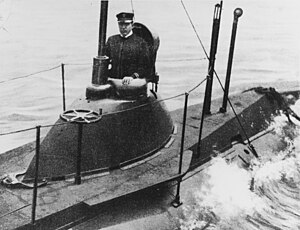USS Plunger (SS-2)

| |
| Career | |
|---|---|
| Ordered: | |
| Laid down: | 21 May 1901 |
| Launched: | 1 February 1902 |
| Commissioned: | 19 September 1903 |
| Decommissioned: | 24 February 1913 |
| Fate: | Sold for scrap |
| General characteristics | |
| Displacement: | 107 tons |
| Length: | 64 ft (20 m) |
| Beam: | 12 ft (4 m) |
| Draft: | 11 ft (3 m) |
| Speed: | 8 knots (15 km/h) surface, 7 knots (13 km/h) submerged |
| Complement: | 7 |
| Armament: | 1 18-inch (457 mm) torpedo tube |
USS Plunger (SS-2) was one of the earliest submarines of the United States Navy. She was the lead ship of the her class and later renamed A-1 when it was designated an A-type submarine.
Early service
The Plunger was originally laid down on 21 May 1901 at Elizabeth, New Jersey, by the Crescent Shipyard. She was launched on 1 February 1902, and commissioned at the Holland Torpedo Boat Company yard at New Suffolk, New York on 19 September 1903. Arthur Leopold Busch supervised the construction of the A-Class submarines that were built at Lewis Nixon's Crescent shipyard in Elizabethport, New Jersey. The proto-type "Fulton" [experimental craft] was laid down prior to these first A-class submarines built for Isaac Rice's Electric Boat Company.
Assigned to the Naval Torpedo Station at Newport, Rhode Island for experimental torpedo work, Plunger operated locally from that facility for the next two years, a period of time broken only by an overhaul at the Holland yard at New Suffolk between March and November 1904. Besides testing machinery, armament and tactics, the submarine torpedo boat also served as a training ship for the crews of new submersibles emerging from the builder's yards.
In August 1905, Plunger underwent two weeks of upkeep before leaving the yard on 22 August. She was towed by the tug USS Apache to New York, where the Plunger would conduct trials near the home of President Theodore Roosevelt. Upon the submarine's arrival that afternoon, She moored alongside the tug and prepared for a visit from Roosevelt.
President Roosevelt
The following morning, Plunger charged her batteries and made a series of five short dives before returning alongside Apache to recharge again. Later that afternoon, Roosevelt boarded the Plunger, made a series of dives before returning to moor alongside the tug almost two hours later. Roosevelt spent almost another hour on board the submarine before he left.
Roosevelt's novel voyage prompted significant interest. On 6 September, Roosevelt wrote from Oyster Bay to Hermann Speck von Steinberg: "I myself am both amused and interested as to what you say about the interest excited about my trip in the Plunger. I went down in it chiefly because I did not like to have the officers and enlisted men think I wanted them to try things I was reluctant to try myself. I believe a good deal can be done with these submarines, although there is always the danger of people getting carried away with the idea and thinking that they can be of more use than they possibly could be." To another correspondent he declared that never in his life had he experienced "such a diverting day ... nor so much enjoyment in so few hours."
Later service
Decommissioned on 3 November, 1905, Plunger remained inactive until 23 February 1907. On 3 May 1909, Ensign Chester Nimitz, the future fleet admiral who would say he considered the submarines of the time "a cross between a Jules Verne fantasy and a humpbacked whale", assumed command of Plunger. That September, the submarine torpedo boat visited New York City to take part in the Hudson-Fulton celebrations.
Reassigned to the Charleston Navy Yard, Plunger reached that port on 24 October, 1909 and moored alongside the gunboat USS Castine, the parent ship for the Atlantic Submarine Fleet. Shortly thereafter, Castine's medical officer, Assistant Surgeon Micajah Boland, inspected Plunger and two other submarine torpedo boats. His report graphically described living conditions on these boats. He found "their sanitary condition to be far from satisfactory, notwithstanding the fact that they had been at sea only about forty-five hours."
Plunger was renamed A-1 on 17 November, 1911. By 1916 it had been authorized to be used as an "experimental target, designated "Target E". She was ultimately hoisted on board the hulk of the former monitor USS Puritan and authorized for sale in 1921, on an "as is, where is" basis. She was sold for scrap in 1922.
See also
- USS Plunger for other United States Navy ships named Plunger.
- USS A-1 for other United States Navy ships named A-1.
References
![]() This article incorporates text from the public domain Dictionary of American Naval Fighting Ships.
This article incorporates text from the public domain Dictionary of American Naval Fighting Ships.
External links
- history.navy.mil: USS Plunger
- navsource.org: USS Plunger
- hazegray.org: USS Plunger
- [1] Lewis Nixon's Shipyard is acknowledged as place where first submarines were developed. Arthur Busch's role is mentioned and acknowledged as builder of Holland's submarines for Electric Boat Company.

